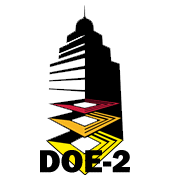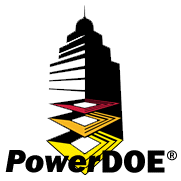Thank you for visiting DOE2.com. This site is the place where you can obtain information and products from the developers of DOE-2 and DOE-2 based products including eQUEST. This site is maintained by James J. Hirsch & Associates.
|
The DOE-2 software was developed by James J. Hirsch & Associates (JJH) in collaboration with Lawrence Berkeley National Laboratory (LBNL), with LBNL DOE-2 work performed mostly under funding from the United States Department of Energy (USDOE) and other work performed mostly under funding from a wide range of industry organizations and ourselves. This site, however, is not sponsored or endorsed by either USDOE or LBNL, and use of “DOE” in names in this site does not imply any endorsement or recommendation of any listed products or services by the United States Government, LBNL, or anyone else. |
Follow this links to review a brief comparison of DOE-2.1E, DOE-2.2, eQUEST and PowerDOE. eQUEST is our most up-to-date complete building energy use simulation tool; it is free and contains a complete version DOE-2.2 and its documentation.
|
Note: Most documents
posted on this website are published using Adobe's Portable Document
Format (PDF) with most using PDF version 1.5 (created using Acrobat
version 9) and may not be readable with versions prior to 6; to update
your Acrobat Reader go to the Adobe site
for a free download. |
|
eQUEST® is a
sophisticated, yet easy to use, freeware building
energy use analysis tool that provides professional-level results with
an affordable level of effort. eQUEST was designed to allow
you to perform detailed comparative analysis of building designs and
technologies by applying sophisticated building energy use simulation
techniques but without requiring extensive experience in the "art" of
building performance modeling. This is accomplished by
combining schematic and design development building creation wizards,
an energy efficiency measure (EEM) wizard and a graphical results
display module with a complete up-to-date DOE-2 (version 2.2) building
energy use simulation program. You
can read the eQUEST
Overview to get a more complete summary of the features and
capabilities of this excellent program. eQUEST 3.65
is the most recent release. For descriptions
of the new features read this
document. eQ_WthProc
can convert EnergyPlus (epw)
files into eQUEST/DOE-2 (bin) files, see weather data area below. You can see more information about eQUEST including download of program and documentation. You can also view the eQUEST download area to see recent versions of the program, documentation and updates. Note: eQUEST is Qualified Software for Calculating Commercial Building Tax Deductions first enacted under the Energy Policy Act of 2005 (EPACT), later extended by the Emergency Economic Stabilization Act of 2008 and most recently extended and modified by the PATH Act of 2015. eQUEST 3.65 is qualified, effective 19 October 2016, for buildings placed into service on or after to January 1, 2016; eQUEST 3.63b is qualified, effective 9 September 2009, for buildings placed into service prior to January 1, 2016. The requirements for software to be qualified for use in these deductions were first covered by IRS Notice 2006-52 and then amplified by IRS IRB 2008-14 and again clarified by IRS IRB 2012-17 with further guidelines provided by DOE and added DOE guidelines for buildings placed in service in 2016 and later. The submission packages, including ASHRAE Standard 140 testing, can be found here.
|
|
|
DOE-2 is a widely
used and accepted freeware
building energy analysis program that can predict the energy use and
cost for all types of buildings. DOE-2 uses a description of the
building layout, constructions, operating schedules,
conditioning systems (lighting, HVAC, etc.) and utility rates provided
by the user, along with weather data, to perform an hourly simulation
of the building and to estimate utility bills. The
“plain” DOE-2 program is a “Command Prompt” program which requires
substantial experience to learn to use effectively while offering
researchers and experts significant flexibility;
eQUEST is a complete interactive Windows implementation of the DOE-2
program with added wizards and graphic displays to aid in the use of
DOE-2. You can review more information about DOE-2 including download of program and documentation. We currently offer you our “latest and greatest” version as well as “legacy” version. DOE-2.2 is the newest DOE-2 building energy simulation and cost calculation engine. DOE-2.2 is the “simulation engine” contained within eQUEST; we strongly recommend you consider eQUEST before trying to use “plain” DOE-2. DOE-2.2 can run in windows versions from XP to 10. DOE-2.1E is the “legacy” version of DOE-2. Note: DOE-2 is Qualified
Software for
Calculating Commercial
Building Tax Deductions first enacted under the Energy Policy
Act of 2005
(EPACT), later extended by the Emergency Economic Stabilization Act
of 2008 and most recently extended and modified by the PATH Act of 2015.
DOE-2.2-48y is qualified, effective
19 October 2016, for buildings placed into service on or after to January 1, 2016; DOE-2.2-047d is qualified, effective
9 September 2009, for buildings placed into service prior to January 1, 2016. The requirements for software to be qualified for use in these
deductions were
first covered by IRS
Notice 2006-52
and then amplified by IRS
IRB 2008-14 and again clarified by IRS
IRB 2012-17 with further guidelines
provided by DOE and added DOE guidelines for buildings placed in service in 2016 and later. The submission packages,
including ASHRAE
Standard 140 testing, can be found here. |
|
|
The Weather Data
& Utilities page provides a description of and access
to weather data processing utilities which provide a variety
of pre-processed weather data compatible with eQUEST, DOE-2.x and
PowerDOE. The available utilities include eQ_WthProc
which can process EnergyPlus (epw)
and DOEWth which can
process NOAA/NCDC (TRY, TMY, etc.) files into eQUEST/DOE-2
(bin) files. Utilities
are also available to process eQUEST/DOE-2 (bin) files,
including the capability to list, convert to/from text format, create
statistical summaries, and other functions. |
|
|
PowerDOE is not available as it has been discontinued in favor of eQUEST. PowerDOE is our previous generation (1990's “legacy”) application; use eQUEST for the most up-to-date user interface and DOE-2 simulation capabilities. PowerDOE included an earlier version DOE-2.2 as its simulation "engine" for all energy and cost calculations. Note that PowerDOE was designed for previous generations of Windows and will not operate properly when installed in more recent versions such as Windows 7. For this reason PowerDOE has been discontinued.
|
|
|
|
The
Life-Cycle Costing (LCC) analysis method is recognized to reliably
identify cost optimal building design solutions yet it is not widely
used with confidence. The National Institute of Standards and
Technology (NIST) and ANSI have suggested standardized LCC nomenclature
and conventions so that the entire buildings industry can speak one
"language" when performing LCC analysis. NIST's LCC
procedures are embodied in the Building Life-Cycle Cost (BLCC) Program;
the NIST BLCC program and related utilities can be downloaded here.
Although the LCC procedures used in BLCC have long been published (NIST Handbook 135 1995 Edition)
some users express concern that BLCC does not display the intermediate
details of its calculations. For this reason we have developed
a spreadsheet version of BLCC procedures. Users of our spreadsheet
version report greater confidence with its user-friendly "glass box"
implementation of BLCC. Our BLCC spreadsheet includes year 2015 USDOE
energy price escalation rates and is available FREE in Excel OfficeXP format (April
2016 version posted 4/22/2016.) View
a detailed description of this spreadsheet tool (sample
screens, advantages, limitations) or a summary
of recent (2015 version) enhancements. |
Send mail to Jeff.Hirsch@DOE2.com with questions or comments about this web site.
Copyright
© 1998-2016 James J. Hirsch. All rights reserved.
eQUEST is a registered trademark of James J. Hirsch. PowerDOE is a registered trademark of the Electric Power Research Institute.




